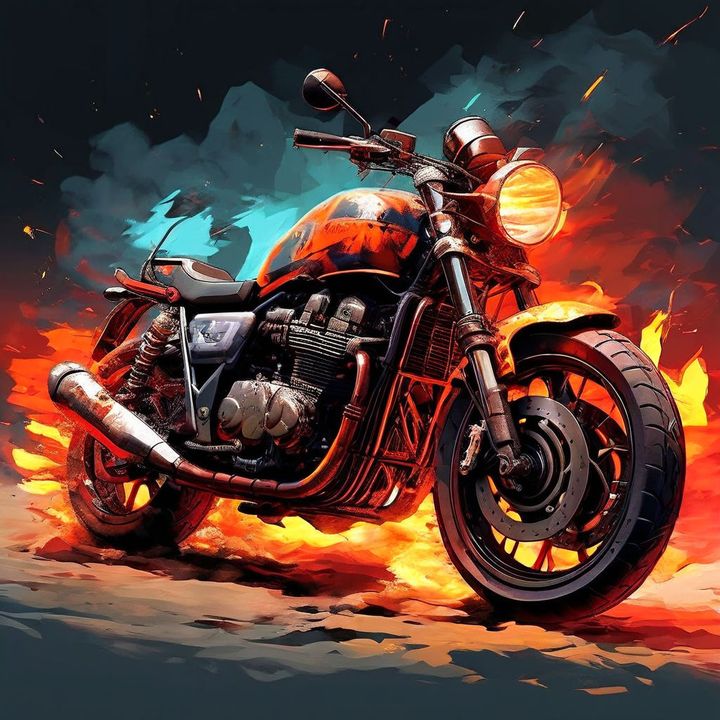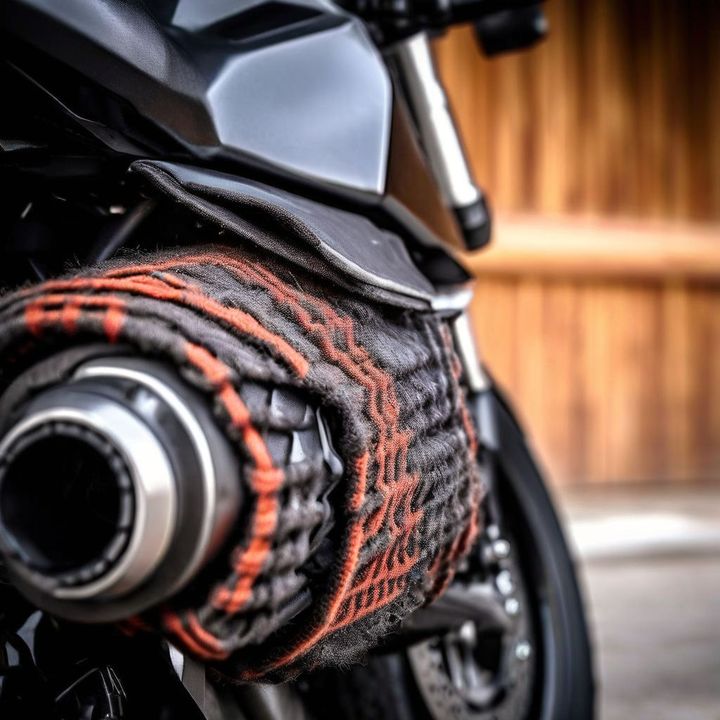


Motorcycle exhaust wraps, also known as header wraps or pipe wraps, are insulating materials designed to cover the exhaust pipes of motorcycles. These wraps are typically made of fiberglass or other heat-resistant materials and are intended to retain heat within the exhaust system. While exhaust wraps can provide certain benefits, such as improved exhaust flow and reduced heat radiation, they can also pose potential problems and dangers if not used correctly.

Before we dive into the potential pitfalls, let's first understand the appeal of exhaust wraps. Many riders are drawn to the sleek, customized look that wraps can provide, transforming the appearance of their exhaust pipes from dull and utilitarian to eye-catching and stylish. Additionally, some believe that wrapping the exhaust can improve performance by retaining heat within the pipes, theoretically increasing exhaust flow and, consequently, engine power.
However, as a mechanic, I've learned that the performance benefits of exhaust wraps are often overstated and can vary significantly depending on the specific motorcycle and riding conditions. The primary purpose of exhaust wraps should be for aesthetic reasons or to protect riders from accidental burns caused by hot pipes.
Now, let's dive into the potential issues that can arise when using exhaust wraps:
| Problem | Description |
|---|---|
| Moisture Trapping and Corrosion | One of the biggest issues with exhaust wraps is that they can trap moisture against the exhaust pipes, leading to corrosion and rust over time. This trapped moisture can cause extensive damage, potentially compromising the integrity of the exhaust system. |
| Pipe Cracking or Failure | The intense heat trapped by the wrap can cause the exhaust pipes to overheat, potentially leading to cracks, warping, or complete failure of the pipes, especially if installed improperly. This issue can result in decreased performance, dangerous leaks of hot gases, and costly repairs or replacements. |
| Discoloration and Aesthetic Issues | While exhaust wraps are intended to enhance the appearance of a motorcycle, they can ironically lead to discoloration and staining of the pipes over time. Once discolored, it's often challenging to restore the wrap's original appearance, and attempting to remove it can further damage the pipes, defeating the very purpose for which they were installed. |
| Potential Overheating Issues | In some cases, wrapping the exhaust can cause the engine to run hotter than intended, taxing the cooling system and potentially leading to overheating or other engine problems. This issue is particularly prevalent on air-cooled motorcycles, where the exhaust system plays a crucial role in dissipating heat. |
As a proactive mechanic, I always recommend regular inspections of exhaust wraps and pipes to identify potential issues before they escalate. Here are some key signs to look for:
Gaps, fraying, or areas where moisture could get trapped against the pipes
Rust, corrosion, or discoloration on the exposed areas of the exhaust pipes
Ticking or knocking noises from the exhaust, which could indicate cracks or damage
Elevated engine temperatures, especially on air-cooled bikes, which could signify overheating
By catching these issues early, you can take appropriate action to prevent further damage and costly repairs.
If you encounter any of the aforementioned problems with your exhaust wrap, it's crucial to address them promptly. Here are some repair and maintenance tips:
Remove the wrap and thoroughly clean and treat any corroded areas on the pipes.
Consider using a rust inhibitor or high-temperature paint before re-wrapping to prevent future corrosion.
Ensure the wrap is installed tightly with no gaps, and avoid soaking it during installation, as moisture can become trapped.
After riding in wet conditions, run the engine until the wrap is completely dry to prevent moisture buildup.
| Repair Option | Description |
|---|---|
| Pipe Replacement | If the pipes are cracked or severely damaged, they will likely need to be replaced. Attempting to wrap over cracked pipes is generally not recommended, as it can accelerate further damage and potentially lead to exhaust leaks. |
| Welding or Patching | In some cases, minor cracks or damage can be repaired through welding or patching techniques. However, this is a temporary solution and may not be suitable for severe damage. |
| Solution | Description |
|---|---|
| Wrap Replacement | Once the wrap is discolored or stained, it's often difficult to restore its appearance. In some cases, the only solution may be to replace the wrap or exhaust system entirely to regain the desired aesthetic. |
| Removal and Cleaning | Removing the wrap may leave permanent marks or discoloration on the pipes, but thorough cleaning and polishing can sometimes improve the appearance. However, this may not be effective for severe staining or discoloration. |
As the saying goes, "an ounce of prevention is worth a pound of cure." By taking proactive measures, you can significantly reduce the likelihood of encountering exhaust wrap problems:

Perform regular inspections and maintenance on the exhaust wrap and pipes.
Avoid riding in excessively wet conditions or ensure the wrap is completely dry after exposure to moisture.
Consider using alternative heat shielding methods, such as exhaust shields or guards, instead of wraps, especially on air-cooled bikes or motorcycles with high-temperature exhaust systems.
Follow proper installation techniques, including overlapping the wrap tightly and using high-quality materials designed for exhaust applications.
Avoid wrapping exhaust systems made of titanium, as the intense heat can cause premature failure of the material.
It's important to weigh the potential risks and costs associated with exhaust wraps against the desired aesthetic or performance benefits. The cost of repairing or replacing damaged exhaust pipes can vary significantly depending on the make and model of the motorcycle, as well as the extent of the damage.
| Cost Factor | Description |
|---|---|
| Exhaust System Replacement | In some cases, a new exhaust system may be required, which can cost several hundred dollars or more, depending on the motorcycle and the quality of the replacement parts. |
| Wrap Replacement | While exhaust wraps themselves are relatively inexpensive, typically ranging from $15 to $50 for a roll, the labor costs for removal and re-wrapping can add to the overall expense. |
| Repair Costs | If the exhaust wrap has caused significant damage to the pipes, the repair costs can quickly escalate, including labor charges for welding, patching, or other repair work. |
As a motorcycle mechanic, I've witnessed firsthand the potential problems that can arise from exhaust wraps. While they can undoubtedly enhance the visual appeal of a motorcycle, it's crucial to weigh the risks and benefits carefully. Proper installation, regular maintenance, and a keen eye for potential issues can help mitigate many of the problems associated with exhaust wraps.
Ultimately, the decision to wrap or not to wrap your exhaust pipes should be based on a thorough understanding of the potential consequences and a willingness to address any issues that may arise. By being an informed and proactive rider, you can enjoy the aesthetic benefits of exhaust wraps while minimizing the risks and ensuring the longevity of your motorcycle's exhaust system.
Exhaust wraps can enhance the visual appeal of a motorcycle by providing a sleek, customized look to the exhaust pipes. They can give an older motorcycle a more retro and eye-catching appearance.
While some believe wraps can increase exhaust flow and engine power by retaining heat, the performance benefits are often overstated and vary based on the specific motorcycle and riding conditions.
The main purpose of exhaust wraps should be for aesthetic reasons or to protect riders from accidental burns caused by hot exhaust pipes.
Trapped moisture can cause extensive corrosion and rust on the exhaust pipes over time, potentially compromising the integrity of the entire exhaust system.
In some cases, wrapping the exhaust can cause the engine to run hotter than intended, leading to potential overheating issues, especially on air-cooled motorcycles.
Signs include gaps or fraying in the wrap, rust or discoloration on the pipes, ticking noises from the exhaust, and elevated engine temperatures.
Once discolored, it's often difficult to restore the wrap's appearance, and the only solution may be to replace the wrap or the entire exhaust system.
Regular inspections, avoiding wet conditions, using alternative heat shielding methods, proper installation techniques, and avoiding wrapping titanium exhaust systems can help prevent issues.
Repair or replacement costs can vary significantly, ranging from the cost of a new wrap to a complete exhaust system replacement, depending on the extent of damage.
Yes, exhaust wrapping is generally considered a permanent modification, as removing the wrap can leave permanent marks or discoloration on the exhaust pipes.

Sarah isn't your average gearhead. With a double major in Mechanical Engineering and Automotive Technology, she dived straight into the world of car repair. After 15 years of turning wrenches at dealerships and independent shops, Sarah joined MICDOT to share her expertise and passion for making cars run like new. Her in-depth knowledge and knack for explaining complex issues in simple terms make her a valuable asset to our team.












